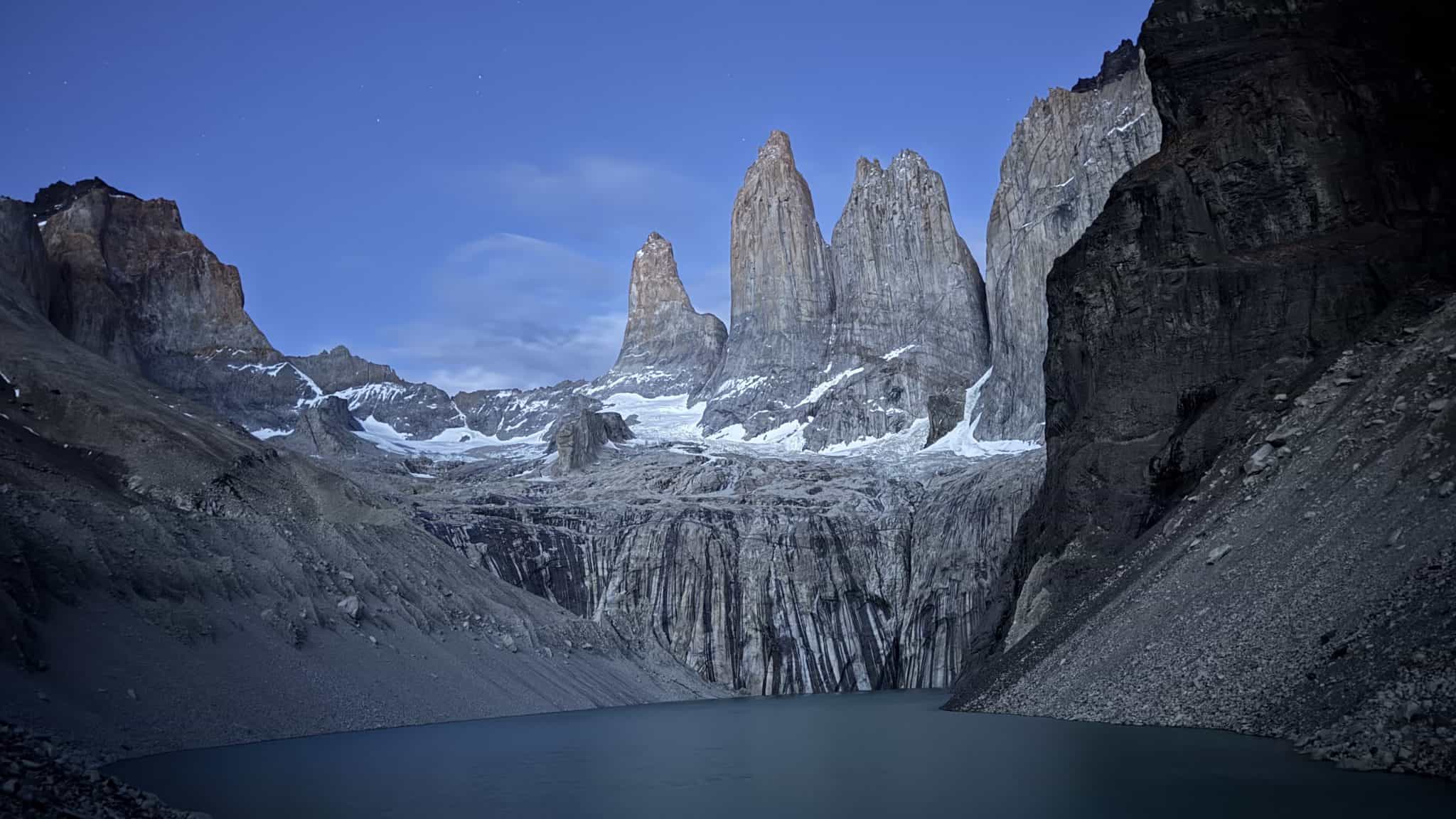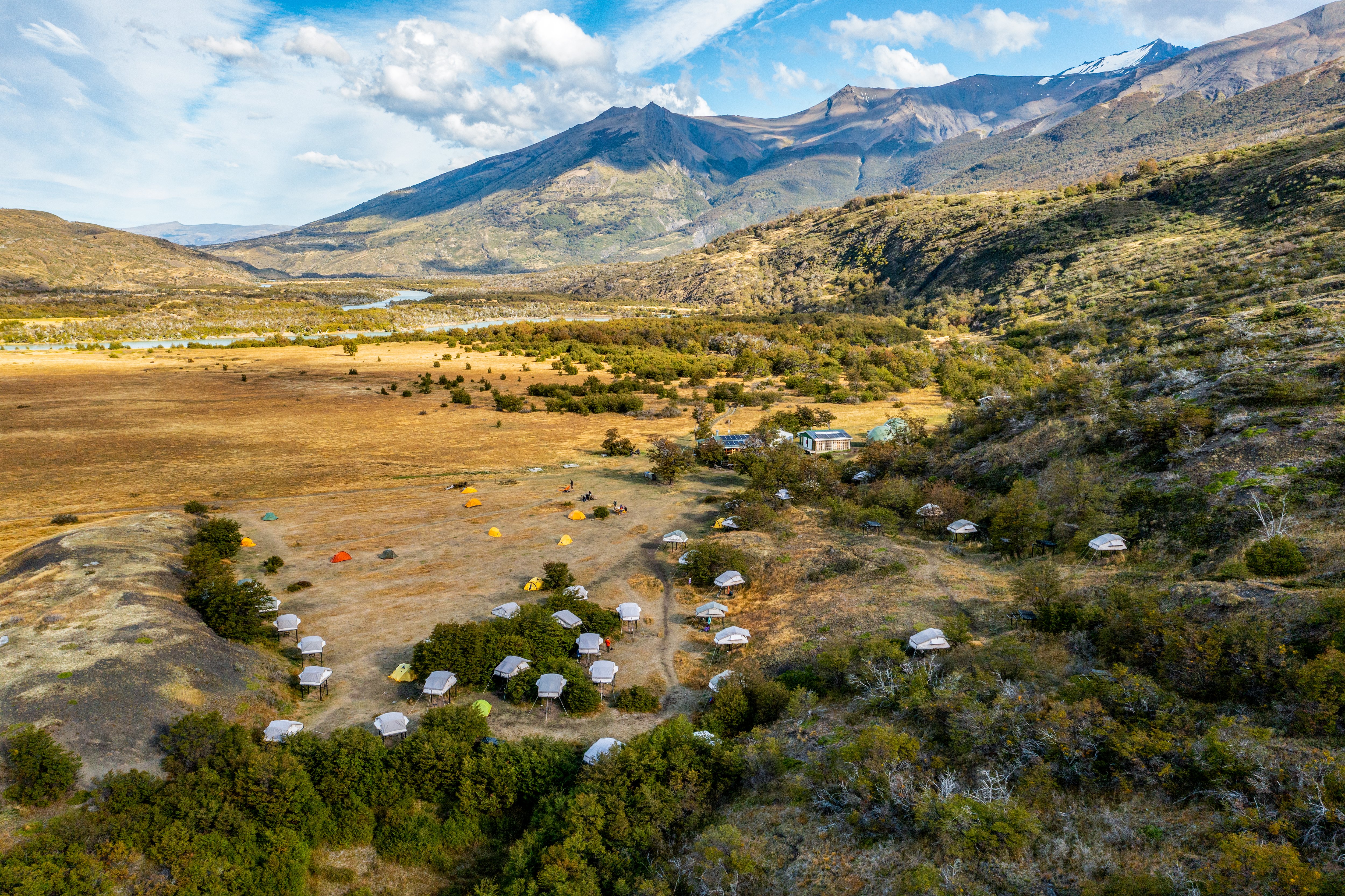Base Torres Trail: Torres del Paine W Trek
- 11 mins
Introduction: I Wish I Could Be There With You!
The first time I saw an image of Torres del Paine, I fell in love. I knew some day I would walk the trail of the Base Torres Viewpoint. Not the kind of love that fades with time or distance, but the kind that anchors itself quietly in your chest—the kind born from a single photo and a gut-deep certainty: I will go there someday.
I didn’t know how or when, only that it would happen. And so, as I planned this long rambling journey through South America—one with nearly 70 possible stops scribbled into notebooks and apps—Torres del Paine stood out like a bold exclamation point. It was non-negotiable.
Long before the transport van entered the park, the towers came into view, jagged and majestic against the sky, I felt less like a visitor and more like someone returning to a place I had always belonged. It was déjà vu layered with awe. I had studied them for years, seen them on postcards, Instagram feeds, even on the back of Chile’s 1,000-peso note—but none of that prepared me for the real thing.
Because that’s the thing about Torres del Paine: it gives you more than you expect. No matter how many guidebooks you read or vlogger videos you watch, this park will hand you something you weren’t ready for. A moment of silence so pure it hums in your ears. A sunrise that paints the towers in impossible colors. A conversation with a stranger that becomes the start of a lifelong friendship.
And perhaps one of the greatest surprises? How beautifully and professionally this park is run. From the world-class hospitality at Hotel Las Torres to the meticulously maintained campsites that feel more like eco-retreats than backcountry refuges, everything here functions with an intentional reverence for the land. Trails are cared for by a quiet army of workers. Organic gardens provide fresh produce. Rangers and staff, many of them locals, act as both protectors and storytellers of this sacred place.
If you’re planning your first journey to Torres del Paine, I wish I could be there. I want to be there when you first glimpse the towers rising in the distance. I wish I could share your delight when you stumble upon something you didn’t plan for—a fox darting across the trail, a stranger handing you hot coffee at sunrise, a moment of stillness that rearranges your soul.
This isn’t just a hike. It’s a memory in the making. A story you’ll tell around countless dinner tables for the rest of your life. And it begins with a trail that leads, quite literally, to the heart of Patagonia.

What is the Base Torres Hike?
Call it the crown jewel of Torres del Paine, the pilgrimage trail, or simply the hike that brought you here in the first place. The hike to the Base Torres Viewpoint is a 19-kilometer (12-mile) round-trip journey that climbs nearly 900 meters (just under 3,000 feet) into the heart of Patagonia’s most dramatic scenery. It’s often the grand finale—or, for some, the dramatic opening act—of the famed W Trek.
But this isn’t just a hike. It’s a shifting symphony of terrain and tension: you’ll wind through sun-dappled lenga forests, tiptoe over rushing glacial streams on narrow bridges, and brace yourself for the final, grueling push—a steep scree slope of loose rock and switchbacks that tests your legs and your will.
And then, at the summit, the reward: the Torres themselves. Three granite monoliths rising from a milky glacial lake, sharp as blades and older than memory. It’s one of the most iconic views in all of South America, and one of those rare moments when the real thing doesn’t just match the hype—it exceeds it.

What makes the Base Torres Viewpoint Iconic?
You will see Torres del Paine as soon as you arrive in Chile. Not in person, but in the crumpled folds of Chilean currency. There they are—three granite spires, proud and unmistakable—etched into the back of the 1,000-peso note like an altar carved in ink. In a country of vast deserts, temperamental volcanoes, and endless coastline, these towers were chosen to represent the soul of the nation’s landscape on its most circulated bill. Roughly the equivalent of a U.S. dollar, the 1,000-peso note is passed from hand-to-hand in markets, kiosks, and cafés across Chile—a pocket-sized postcard from Patagonia.
It’s rare for paper money to be this poetic. The U.S. dollar boasts presidents and pyramids. The euro rotates through architecture and abstraction. But Chile chose to elevate nature to its currency—literally. The Torres, which rise like prehistoric cathedrals from the basin of Torres del Paine National Park, are not only geographical marvels; they are symbols of endurance, elegance, and the sublime scale of this wild land.
To see them in person is to feel the quiet majesty that no photograph—or banknote—can quite capture. At dawn, when the light hits the spires just right, they blush with a golden pink glow that silences even the most chatty hikers. It’s a humbling moment. You feel small, and somehow larger for it. That’s what makes the Torres iconic. Not just their height or their grandeur, but the visceral truth they hold up to you: this is Chile, distilled—raw, resilient, and unforgettable.
Putting the Torres on the 1,000-peso note wasn’t just a design choice; it was a declaration. Chile wasn’t going to memorialize a general or a king. It would honor stone and sky. It would remind its people and its visitors that the country’s real wealth isn’t held in vaults—it’s out here, where the wind howls, the guanacos graze, and the mountains wait like old gods, unmoved and magnificent.
So the next time you get change in a roadside café or tip a guide after a hike, take a second look at that green and white bill. It’s more than money. It’s a pilgrimage in your palm.

Chose your mountain stay to the Base Torres Viewpoint: Central or Chileno
As you prepare for the iconic hike to the Base Torres Viewpoint—the crown jewel of Torres del Paine—you’ll face your first important decision before you even lace up your boots: Where will you sleep the night before?
There are two primary options within the park, and each offers a very different prelude to the adventure ahead.
The first, Central Sector, greets you almost immediately as you enter Las Torres Patagonia. With its rustic lodge-style charm and social buzz, this is the hub of hiker activity. Stay here, and you’re plunging into the park’s vibrant rhythm—you’ll share meals with trekkers just arriving wide-eyed from the road, others returning dusty and triumphant from the trail, and many, like you, nervously preparing for the legendary climb to the Base Torres Viewpoint. It’s lively, communal, and full of stories in progress.
For those craving a quieter, more immersive start, Chileno Sector offers something entirely different. Tucked into the valley roughly halfway up the trail to the towers, it’s smaller, more intimate, and feels like a secret whispered by the mountain itself. Staying here shaves several kilometers off your morning hike—meaning you can begin the final ascent with a headlamp and a thermos of coffee, aiming to catch that soul-stirring moment when the sun lights the granite spires in hues of fire and gold.
Both sectors require advance booking—often months in advance—so don’t leave your decision to chance. Whether you choose the social energy of the valley floor or the serenity of the midway refuge, what matters most is what lies ahead: one of the most unforgettable views on Earth, waiting just beyond the final ridge.

Central Sector (managed by Las Torres Patagonia)
If Torres del Paine is a pilgrimage, then Central Sector is its bustling basecamp cathedral—a place where dusty boots clatter against wooden floors, steaming plates of food are placed in front of hungry hikers, and strangers become storytellers over shared bottles of Chilean wine.
Located just inside the entrance to Las Torres Patagonia, this is more than just a place to sleep. It’s a warm, fast-paced waystation where the energy is palpable. At dinner, your communal table will fill with travelers from every corner of the world. Conversations ignite almost instantly—someone’s just come off the W, someone else is about to tackle the O, and a few, perhaps like you, are gearing up for the trail to the Base Torres Viewpoint. Tales of windstorms, condor sightings, and trail misadventures swirl through the room like smoke from the wood-fired stoves. There’s no ice to break here—the park has already done it for you.
But it’s not just the camaraderie that makes Central Sector so memorable—it’s the view. Of all the sectors and hotels scattered across the national park, none offer a more cinematic frame of the towers themselves. From my bedroom window, I could see the towers rise in the distance. Each morning, I’d wake just before sunrise and watch as the first light painted the granite spires in a soft, surreal blush. It felt like a private showing of Patagonia’s most iconic masterpiece.
Central Sector hums with the rhythm of the park: early risers packing daypacks, late arrivals shaking off the road, and always, somewhere in between, a new friend offering you coffee, advice, or just a listening ear. It’s not just where the hike begins—it’s where the story starts.

Chileno Sector (managed by Las Torres Patagonia)
Tucked deep in the Ascencio Valley and hugged by lenga forest, Chileno Sector feels like a whispered secret halfway up the mountain. Smaller, quieter, and more intimate than its valley-floor counterpart, this is where you go to trade the buzz of the crowd for the rustle of trees and the sound of the river just beyond the trail.
Getting here requires a bit of effort—it’s a steady uphill climb from the park entrance, about two hours on foot—but for those who make the journey, the reward is serenity. Hikers at Chileno tend to turn in early, rising before dawn to make the final push to the Base Torres Viewpoint in time for sunrise. There’s no bar scene, no bustle—just headlamps, hot tea, and the shared anticipation of what’s to come.
But that quiet doesn’t last forever.
By afternoon, Chileno transforms. What was hushed and still the night before becomes one of the liveliest waypoints in the entire park. As morning hikers descend from the viewpoint, dusty and elated, Chileno becomes the universal stopover—for food, for water, for the bathroom, for a breath. There’s laughter echoing off the trees, boots kicked off beneath picnic tables, and that unmistakable scent of fresh empanadas drifting from the kitchen. For a few golden hours, this little mountain refuge becomes a high-altitude café, trail junction, and social salon all in one.
Then, just as suddenly, it quiets again. The hikers move on, the light begins to fade, and Chileno returns to its gentle rhythm—halfway to the towers, and a world away from everything else.

Another Torres Base Trail Option: Hotel Las Torres
For those seeking the thrill of adventure without sacrificing a warm shower, a plush bed, and a glass of Chilean wine at day’s end, there’s yet another option along the Torres Base Trail—one that comes with a few more creature comforts.
Hotel Las Torres, nestled right at the edge of the national park and within striking distance of the Base Torres Viewpoint trailhead, offers an upscale experience in the heart of the wilderness. While most hikers shoulder their packs and bunk up in rustic refugios, guests at the hotel return from the same rugged trails to soft linens, gourmet meals, and the kind of hospitality you’d expect from a world-class lodge—not a mountain outpost.
But don’t mistake it for a bubble-wrapped resort. This isn’t luxury that separates you from the park—it immerses you in it. Wake up to horses grazing outside your window, sip coffee while gazing at the towers, and chat with expert guides over pisco sours as you plan the next day’s trek. The hotel even offers early breakfast and trail-ready boxed lunches.
Yes, it’s a splurge. But for many, it’s a welcome balance: the raw beauty of Patagonia paired with the comfort of returning each evening to a place that feels like home—if home had views like these.
An Amazing Opportunity for Astrophotography
In most places, the stars are a background detail. In Torres del Paine, they’re another one of the main attractions.
Far from city lights and nestled deep in the Patagonian wilderness, the night sky here feels impossibly vast—an ancient canvas dotted with constellations, streaked with the glow of the Milky Way, and, if you’re lucky, brushed by the ghostly shimmer of the Southern Lights. It’s the kind of sky that makes you stop mid-step, neck craned, mouth open, camera forgotten.
But don’t forget your camera.
Bring a tripod if you have one, but even without it, modern smartphones can work wonders. If you’re using an iPhone, set the exposure to its maximum (typically 10 seconds), steady your hand—or prop the phone on a rock—aim toward a cluster of stars, and shoot. The result? A dazzling constellation map captured in your palm. Nebulae, shooting stars, even the subtle hues of interstellar dust clouds become visible to the lens, if not always to the naked eye.
Astrophotography, at its core, is about patience and presence—two things Torres del Paine offers in abundance. So pause on your climb, look up, and take a shot. You’re not just photographing the stars. You’re capturing a piece of the universe that most people will never see.

Final Thoughts: Why It’s Worth It
The wind in Patagonia doesn’t whisper. It speaks in gusts and growls, in a language you learn not with your ears, but with your bones. And when you agree to meet it before sunrise—somewhere at the edge of the world—you don’t arrive expecting comfort.
This is the Base Torres Trail—to those famous granite spires that have become the symbol of Chilean Patagonia and, perhaps, the closest thing this continent offers to a pilgrimage. Not spiritual in the traditional sense, but sacred all the same.
What they don’t tell you in the brochures is that it’s hard. The kind of hard that makes your thighs scream and your mind question your decisions. And yet, there is clarity in this effort. A stripping away of noise. By the time you reach the final ridge—a tangle of rock and snow shaped by glaciers long gone—you’re no longer anyone’s job title, or tax bracket, or Instagram handle. You’re just a person. Hiking uphill. In the dark. For the chance to witness something honest.
You sit on a boulder in silence. Wrapped in every piece of clothing you packed. Your socks are damp. Your fingers are numb. And yet, there’s no place else you’d rather be.
Because here, in this unforgiving corner of the world, nothing is guaranteed. Not comfort. Not warmth. Not even a view (because sometimes it's cloudy). But when it comes—if it comes—it feels earned. And in a world that hands out too many rewards for too little effort, that matters.
That’s why you hike here.
Not because it’s easy.
But because it’s real.
By Forrest Mallard.




